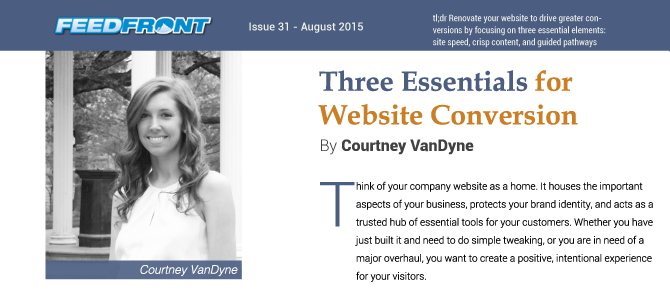Think of your company website as a home. It houses the important aspects of your business, protects your brand identity, and acts as a trusted hub of essential tools for your customers. Whether you have just built it and need to do simple tweaking, or you are in need of a major overhaul, you want to create a positive, intentional experience for your visitors.
The Power Supply: Site Speed
Site speed can significantly impact your website’s ability to convert. Fifty-seven percent of consumers will abandon a page that takes longer than three seconds to load (PhoCusWright)—this statistic cannot be ignored in an industry reliant upon the success and profitability of online marketers. Consider using Google Page Insights to pinpoint specific problem areas. This tool suggests simple fixes for problems it detects within your site. Additionally, make a conscious effort to compress image files as you go. Reducing the size (in bytes) of graphic files will speed up your downloads and improve page rendering time for repeat visitors.
The Blueprint: Guided Pathways
To a new visitor, websites may often feel like a complicated maze of pages, where the information you seek is not always easy to find. Setting up guided pathways throughout your site is essential to capturing your visitors’ attention, and ultimately guiding them along a path of conversion.
In a home, there are various pathways leading to different parts of the house. The navigational elements found in your home can translate to your website. For example, hallways act as your main menu items, doorways are your sub-menu items, and stairs escalate visitors to a new level of commitment, your call to action.
- What is the main purpose of this page?
- How will this page direct the visitor closer to a conversion?
Consistent placement and color of call to action buttons enables visitors to get to the desired endpoint, faster. Remember to show your visitors where they are in relation to the rest of the site.
The Interior Design: Crisp Content
Brevity is levity (William Shakespeare). If numerous items are emphasized, they lose importance. Desired conversion actions should be obvious. Avoid burying key selling points below the fold or under lengthy content.
If you find yourself sifting through a large mass of content, be mindful of your target audience and your core conversion goal. Keep the points that draw your visitors’ attention to those goals. Eliminate the rest; or, consider adding a ‘read more’ link, providing additional content on a secondary page. Don’t allow your content to compete with itself, but rather, position your text in a way that compliments your main selling points.
Whether you choose to renovate your website piece-by-piece, or all at once, remember to welcome and guide your visitors towards your desired conversion goals. Give them a positive experience—a reason to return to your site in the future.


